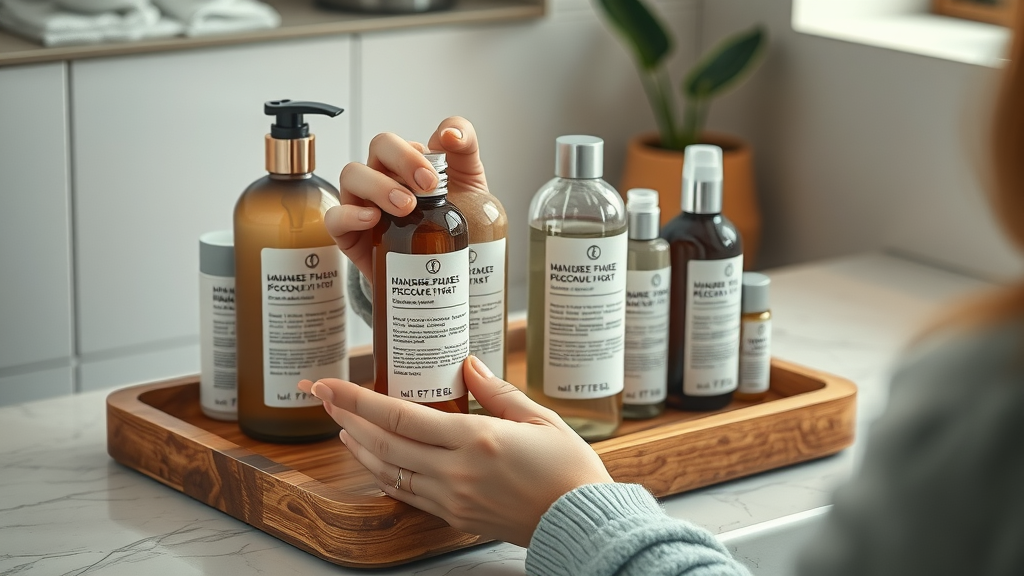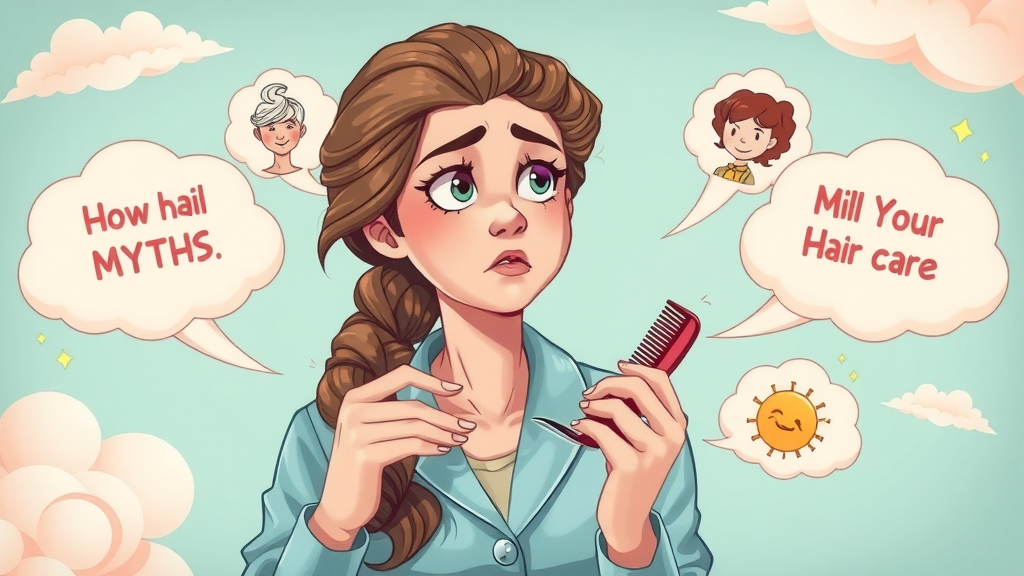Did you know that nearly 80% of people miss key steps in their healthy hair routine , causing preventable damage and lackluster hair health? That surprising statistic underscores why developing an effective hair care routine isn’t just a beauty trend—it's the foundation of lifelong healthy hair. Whether you're hoping to strengthen long hair, encourage hair growth, or finally say goodbye to endless cycles of hair damage and split ends, this guide will walk you through every essential, often-overlooked step.
From busting stubborn hair care myths to discovering the perfect products for your hair type , get ready to transform your routine into a proven system that delivers real, lasting results.
Unlocking the Secrets of a Healthy Hair Routine: Surprising Facts Every Hair Care Enthusiast Should Know

"Did you know that nearly 80% of individuals are missing key steps in their healthy hair routine, leading to preventable hair damage and suboptimal hair health?"
The path to a healthy hair routine begins with recognizing the crucial steps most people overlook. For example, skipping scalp care, overusing heat styling tools, or using hair products unsuitable for your hair type can all lead to dry hair, split ends, and even hair loss. Instead, tailoring your hair care routine with insights from hair health science supports the hair shaft and follicle, maximizing each strand’s strength and shine. According to leading trichologists, daily habits matter just as much as occasional treatments; the right balance of gentle cleansing, smart conditioning, and protection from environmental stressors can make or break your results.
Scientific research also reveals hair health is not just external; a healthy scalp environment, regular nourishment, and even diet have powerful effects on hair follicles. As you read on, you’ll learn the exact steps experts recommend so your care routine addresses all these critical factors.
Achieve Your Best Hair Yet: What a Healthy Hair Routine Can Do for You
- Understand what comprises a healthy hair routine and its benefits for all hair types
- Learn how to tailor your hair care routine to your unique hair type and lifestyle

- Discover expert-endorsed products and techniques to enhance hair health
- Find out how to protect your hair and scalp against everyday damage
A well-designed healthy hair routine can transform the look and feel of your hair, no matter your starting point. By consistently incorporating best practices, you’ll notice more resilient strands, reduced breakage, and a healthy, natural sheen that makes your hair easy to style and maintain. Customizing products and habits for your unique needs—such as using air dry methods for fine hair, or deep conditioning for curly hair—amplifies these benefits across all hair types.
Personalization is key. The right routine will ensure your hair and scalp stay hydrated, your long hair remains strong, and any signs of hair damage, such as split ends or dry hair, are minimized. Whether your goal is to let your hair grow longer or simply achieve an overall improvement in hair health, a consistent, expert-informed care routine truly delivers lasting results.
Understanding the Fundamentals: What Is a Healthy Hair Routine?
Healthy Hair Routine Defined: Components That Make a Difference
A healthy hair routine is a set of everyday and weekly care steps, adapted to your hair type, that keeps your hair shaft nourished and strong while supporting scalp health for optimal hair growth. This often includes gentle shampooing, applying conditioner specifically suited to your hair type, protective treatments like leave-in products, and weekly deep conditioning or hair mask sessions. For many, incorporating steps like scalp massage and limiting exposure to intense heat also become a cornerstone of their care routine. Regardless of whether you have fine hair, curly hair, or oily hair, a consistent and comprehensive routine is crucial for maintaining hair health.
In addition to the basics, a truly effective care routine involves monitoring product performance, tracking changes in hair health, and adjusting to factors like humidity, season, or hormonal shifts. Building habits such as air drying where possible and using a wide-tooth comb on wet hair can be especially important for minimizing hair damage and protecting your hair’s natural oils.
The Science Behind Hair Health and Hair Care Routines
Understanding the science of hair care can supercharge your routine. Hair is made up of the cuticle (outer layer), cortex (middle), and often a central medulla. Damage usually starts at the cuticle, leading to frayed, porous strands if neglected. Using gentle cleansers and nourishing conditioners helps seal the cuticle, maintains the hair shaft integrity, and reduces breakage. Importantly, scalp health—a healthy balance of sebum, or natural oils—directly fuels hair follicles, supporting strong, continuous hair growth.
When choosing hair products, look for ingredients that restore moisture and protein. Hair masks rich in natural oils, proteins, and hydrating agents should be part of every routine. These not only restore shine but also address the unique needs of your hair type and lifestyle.

Healthy Hair vs. Damaged Hair: Key Differences
How can you tell the difference between healthy hair and hair damage ? Healthy hair feels soft, provides natural shine, and resists split ends or tangles. It has strong elasticity, meaning a strand can stretch (slightly) and return to its shape without snapping. Damaged hair, in contrast, appears dull, frizzy, and often breaks or splits easily.
When hair cuticles are compromised by harsh chemicals, heat, or environmental stressors, the hair shaft loses moisture and becomes brittle. Restoring a healthy hair routine—focusing on protection, hydration, and tailored products—can bring even the most damaged strands back to life if applied consistently. Monitoring these indicators is vital for anyone looking to maintain long-term hair health, especially those prone to long hair breakage or ongoing hair loss.
Identifying Your Hair Type: The Foundation of Every Successful Healthy Hair Routine
| Hair Type | Main Characteristics | Best Care Routine |
|---|---|---|
| Straight Hair | Shiny, tends to be oily, tangles less | Mild shampoo, lightweight conditioner, wash every 2–3 days, minimal styling products, use of tooth comb on wet hair |
| Wavy Hair | Body and bounce, prone to frizz | Sulfate-free shampoo, anti-frizz serum, regular deep conditioning, avoid heavy products |
| Curly Hair | Defined curls, dries out quickly, shrinkage | Moisture-rich shampoo and conditioner, weekly hair mask, leave-in products, finger detangling |
| Coily Hair | Tight curls, very dry, prone to breakage | Gentle cleansing, intense hydration with oils/butters, frequent conditioning, low-manipulation styling |
How to Recognize Your Hair Type and Texture

The first step toward an effective healthy hair routine is accurately identifying your hair type . Start by observing how your hair behaves when air dry versus after washing your hair. Straight hair usually lays flat and shines brightly due to natural oil distribution along the hair shaft. Wavy hair shows loose "S" shaped patterns and may frizz depending on humidity. Curly hair forms spirals, loses moisture quickly, and benefits from heavier hydration. Coily hair, with its tight coils, is most fragile and demands extra care to avoid hair damage and maintain healthy hair.
Understanding your unique hair type allows you to select the right hair products, adjust your washing frequency, and determine which treatments will enhance your hair’s natural strengths.
Customizing Your Healthy Hair Routine for Curly, Straight, Wavy, and Coily Hair
Each hair type demands specific care to achieve optimal hair health. Curly hair needs intensive moisture and gentle, finger-based detangling—using a wide-tooth comb only on wet hair. Straight hair , which is prone to oily hair, thrives with mild cleansers and minimal product buildup. Wavy hair benefits from anti-frizz products and masks to sustain bounce. Coily hair should prioritize heavy creams or butters and protective styles that reduce manipulation and prevent split ends.
Regular assessment and tweaking of your care routine also fit common life changes—like shifts in climate, or adjusting for sports or workout habits—ensuring your routine continues working for you as your hair type evolves. By focusing on your specific needs, you’ll see stronger, healthier hair that better resists breakage and retains natural oils.
Choosing the Best Hair Care Products for a Healthy Hair Routine
How to Decode Labels and Spot Quality in Hair Care Products
Selecting the best products for your healthy hair routine starts with reading labels and understanding key ingredients. Avoid products with sulfates, parabens, or drying alcohols—these can strip natural oils from the hair shaft, leading to dry hair and split ends, especially for long hair or curly hair types. Instead, choose formulas rich in gentle cleansers and replenishing agents, such as natural oils and proteins suited to your care routine.
Look for keywords like “moisturizing,” “repair,” or “strengthening,” but don’t be fooled by marketing jargon. Check for recognizably healthy ingredients near the top of the label, and steer clear of excess synthetic fragrances that can irritate sensitive scalps. Consulting trusted online reviews or asking your stylist can reinforce your decision, guaranteeing your hair care products support—not sabotage—your path to healthy hair.
Essential Ingredients to Look for in a Healthy Hair Routine

Certain ingredients deliver proven benefits for hair and scalp health. Seek out formulas including:
Natural oils (argan, coconut, jojoba, olive)—restore lost moisture, boost shine, and nourish hair follicles.
Proteins (keratin, silk amino acids, hydrolyzed wheat)—fortify the hair shaft, encourage hair growth, and prevent breakage.
Glycerin and panthenol —moisturize and seal in hydration, vital for combating dry hair or split ends.
Tea tree oil and salicylic acid —support scalp health and reduce itchiness or flaking.
Adding targeted serums or leave-in treatments incorporates another layer of damage prevention, especially for fine hair or hair that’s frequently heat styled or color treated.
Best Practices for Selecting Shampoo, Conditioner, and Leave-In Treatments
For a healthy hair routine, choose shampoos and conditioners tailored to your specific hair type and concerns. Those with oily hair might need a clarifying formula just once a week, while individuals with dry hair or curly hair should select hydrating, sulfate-free cleansers and richer conditioners. Leave-in conditioners or serums mitigate further hair damage by sealing the cuticle and defending against environmental stressors.
Don’t forget: Overwashing can strip away natural oils, while using too much product risks buildup and limpness. Confirm each product is free of harsh chemicals, and try to rotate based on your changing needs—especially if you notice scalp irritation or product fatigue.
Step-by-Step Healthy Hair Routine for Every Hair Type
Establishing a Daily and Weekly Care Routine
To unlock optimal hair health , implementing a daily and weekly care routine is essential—regardless of whether you’re working with curly hair, long hair, fine hair, or otherwise. Start every morning by cleansing the scalp with a mild shampoo (adjust frequency according to your hair type), followed by a lightweight, moisture-balancing conditioner. Next, apply a leave-in treatment for extra protection against daily wear, humidity, and styling frizz. In the evening, focus on calming scalp massage to stimulate hair follicles and distribute oils, and nightly protection using silk bonnets or pillowcases. Reserve targeted hair masks or deep conditioning for once a week.
These practices align with professional care routine standards and address the entire hair and scalp environment, maximizing both hair growth and strength.
- Morning: Cleansing with mild shampoo, Applying lightweight conditioner, Leave-in nourishment
- Evening: Scalp massage, Nighttime protection, Weekly mask
How Often Should You Wash Your Hair for Optimal Hair Health?

The frequency of washing your hair can make or break your healthy hair routine . For oily hair or straight hair, 2–3 times per week is usually optimal. Individuals with curly or coily hair should aim for once or twice weekly, preserving natural oils and preventing dry hair. Overwashing—especially with harsh shampoos—risks stripping the hair shaft, disrupting the scalp, and causing hair damage.
Listen to your scalp: Adjust washing cadence for climate, workout frequency, or if you notice changes in your hair’s oil balance. Remember, it’s not just about frequency but also about gentle, thorough cleansing with the right product for your hair type.
Gentle Techniques for Wet Hair, Combing, and Detangling
Wet hair is most vulnerable to breakage and split ends. Always use a wide-tooth comb for detangling and avoid aggressive towel drying—microfiber towels or soft cotton tees minimize friction. Start by gently patting your hair dry, then work in small sections from ends to roots using slow, careful motions. For extra protection, apply a leave-in conditioner or light detangler while your hair is still damp to help the comb glide smoothly.
If you blow dry, set your dryer to low or medium heat, use a heat protectant spray, and try to air dry whenever possible to preserve hair health. Prioritize these techniques to maintain healthy hair, especially after washing and during styling sessions.
Deep Treatments: The Game-Changer in a Healthy Hair Routine
Why Hair Masks & Deep Conditioners Are Essential
In every expert-approved hair care routine , deep treatments like hair masks and conditioners are non-negotiable. These potent treatments restore lost moisture, reinforce hair shaft strength, and rescue strands from cumulative environmental and styling damage. Regular use of nourishing masks, particularly on long hair, fine hair, or curly hair, shields your hair from future breakage and supports lasting shine and elasticity.
A once-weekly hair mask—whether homemade or store-bought—can transform even the driest hair. Pay extra attention to ends, where old growth is most at risk for split ends and dullness.
- Avocado and olive oil mask (DIY): Hydrates and repairs dry hair
- Coconut milk mask (DIY): Strengthens fine hair and restores bounce
- Keratin-infused mask (professional): Reduces breakage in long hair
- Honey, yogurt, and aloe vera (DIY): Adds shine and fights frizz in curly hair
- Argan oil deep conditioner (professional): Protects from split ends and boosts hair health
How to Apply Hair Masks for Maximum Effectiveness
To maximize benefit, always apply hair masks evenly to clean, damp hair. Separate your hair into sections and work the mask from mid-lengths to ends, being generous on areas prone to breakage or dryness. Use a wide-tooth comb to distribute product evenly across the hair shaft. Cover your hair with a shower cap for 15–30 minutes to trap warmth and help your strands absorb nutrients efficiently. Rinse thoroughly with cool or lukewarm water to maintain moisture balance.
For enhanced results, incorporate heat by sitting under a dryer cap or wrapping a warm towel around your head. Consistency is key—make masks a ritual in your care routine for noticeable hair health improvements.
Nourishing Your Hair and Scalp from Within
Diet and Nutrition: Fueling Hair Health from the Inside
- Eggs and lean meats for protein and biotin (hair growth and follicle strength)
- Berries and vitamin C-rich fruits for collagen production
- Leafy greens (iron and vitamin A for scalp health)
- Walnuts, salmon, and flaxseed for omega-3s (shine and moisture retention)
- Supplements: biotin, zinc, and multivitamins (for hair health support)

What you eat dramatically impacts the strength, shine, and resilience of your hair. Adequate protein intake supports the hair shaft and follicle during active growth phases. Foods high in antioxidants help prevent premature hair loss and scalp inflammation by keeping the scalp environment optimal for new hair growth. Incorporate these foods and supplements into your diet to support your healthy hair routine from within.
Staying Hydrated for Optimal Hair and Scalp Health
"The health of your hair and scalp reflects the nutrients you consume every day." – Trichology Expert
Hydration matters as much for your hair and scalp as it does for your overall wellness. Drinking plenty of water daily helps deliver nutrients to hair follicles, maintains the health of your scalp, and keeps strands supple. Dry hair and scalp are often the result of inadequate hydration, not just external factors.
If you notice persistent flaking, itchiness, or brittle hair, boost your water intake as a simple yet effective way to supercharge your hair care routine. Pair proper hydration with nutrient-rich foods for an unbeatable, inside-out approach to healthy hair.
Protection Methods: How to Prevent Hair Damage and Maintain Healthy Hair
Protect Your Hair from Heat, Sun, and Environmental Stressors
Environmental factors can wreak havoc on even the best healthy hair routine . UV rays, humidity, wind, and pollution all contribute to hair damage, breakage, and color fading. Wearing hats or silk scarves outdoors shields long hair and colored hair from intense sun exposure. At home, regular use of leave-in conditioners or protective sprays can minimize heat styling damage and lock in natural oils.
If you rely on blow dry or straightening tools, always apply a heat protectant first and try to air dry whenever possible to maintain hair shaft integrity.
Simple Tips to Reduce Hair Damage from Styling Tools
Heat and mechanical styling—if unchecked—accelerate hair damage and make split ends inevitable. To protect your hair, use styling tools with adjustable temperature controls and always start on the lowest setting. Space out heat styling sessions and allow your hair to recover with air drying or no-heat styles in between. If you love blow dry volume, use a heat protectant and finish with a cool shot to seal the cuticle.
Choose wide-tooth combs and soft-bristle brushes to detangle wet hair gently and always tidy up with your fingers or a comb after styling to maintain hair health.
- Microfiber towel or cotton t-shirt to reduce split ends
- Silk pillowcases and scrunchies to prevent breakage
- Leave-in protectants and nourishing serums
- Regular trim to manage split ends
- Heat protectant spray for blow drying or curling

The Role of Scalp Care in Your Healthy Hair Routine
Maintaining the Right Scalp Environment for Hair Growth
Optimal scalp health is the ground zero for healthy hair. A clean, lightly exfoliated scalp allows hair follicles to function without obstruction, supporting robust hair growth and minimizing conditions like dandruff or hair loss.
Incorporate gentle scalp massagers into your weekly routine to improve circulation and evenly distribute natural oils. If you use styling products daily, consider a clarifying shampoo every two weeks to remove buildup, but always follow with hydration.
How to Choose the Right Scalp Treatments
Look for treatments with nourishing oils (tea tree, peppermint, argan) or targeted ingredients (salicylic acid, niacinamide) to soothe irritation and stimulate the scalp. If you have specific scalp issues—such as flaking, itching, or excess oil—select products tailored for those challenges. For best results, patch test any new product to avoid sensitivities.
Balanced scalp treatment is part of a truly effective care routine and allows your hair follicles to thrive, ensuring lasting hair health.
Debunking Myths Around Healthy Hair and Hair Care Routines

Common Misconceptions: Do You Need to Change Your Care Routine Often?
Contrary to popular belief, you don’t need to overhaul your hair care routine every season or with each new trend. Instead, focus on core practices—cleanse, condition, protect, treat—and only update products when you notice real changes in hair health (excess dryness, scalp irritation, or hair loss). Sudden, frequent shifts can disrupt your hair’s equilibrium.
Stick to a foundation that serves your hair type, adjust for big lifestyle changes, or introduce targeted treatments when necessary.
The Truth About Hair Products and Hair Types
It’s a myth that expensive hair products alone guarantee healthy hair or that you must use dozens of products daily. What matters is choosing formulas matched to your hair type and addressing your true needs—like moisture for curly hair or strength for fine hair. Layering too many products can cause buildup and dullness, interfering with hair growth and scalp health.
A streamlined, targeted approach built on evidence-based principles will always outperform a cluttered, unfocused routine.
Personalizing Your Healthy Hair Routine for Results That Last
Adapting Your Routine to Lifestyle, Climate, and Seasonal Changes

A healthy hair routine should adapt to your life. Hot, humid climates might require lighter products and more frequent washes for oily hair, while drier seasons call for extra hydration and weekly hair masks. If your routine involves regular workouts or swimming, install scalp cleansers and UV-protection sprays for added defense.
Track product performance and tweak routines as your environment, schedule, or hair health evolves. The most effective routine is one that evolves with you.
Tracking Progress and Making Data-Driven Adjustments
Keep a simple hair journal—note how your hair responds to new products, styles, and treatments every month. Document split ends, scalp sensitivity, and the general feel or look of your hair. Review these notes to spot trends: Is your scalp getting dry when you change shampoos? Does a new hair mask improve shine?
Use your data to make small, informed adjustments, ensuring your healthy hair routine continues to deliver results and preempt potential hair damage.
People Also Ask: Expert Answers About Healthy Hair Routines
What is the healthiest hair routine?
The healthiest hair routine is simple: gentle shampooing, targeted conditioning, weekly deep treatments or masks, minimal heat styling, and consistent scalp care. Adjust all steps to your specific hair type (curly, straight, fine, or coily) and lifestyle. Include diet and hydration for overall hair health, and always protect hair from environmental stressors like sun and pollution for lifelong results.
What is the best 7 day hair care routine?
A great 7-day hair care routine combines regular cleansing (2–3 times per week for most types), daily leave-in protection, evening scalp massage, and a single deep conditioning session. Limit heat styling, detangle with a wide-tooth comb, and use protective styles or accessories. Adjust based on hair type and weekly activities for best results.
What are the 4 qualities of a healthy hair?
Healthy hair is strong (resistant to breakage), shiny (reflects light evenly), elastic (stretches without snapping), and soft (smooth texture, tangle-free). These qualities result from consistent care, balanced hydration, and good scalp health. If your hair exhibits all four, your routine is delivering what your follicles need.
How do I train my hair to be healthy?
Start with consistent cleansing and conditioning, followed by regular hydration and minimal heat exposure. Transitioning to less frequent washes trains your scalp to regulate oil production naturally. Use a focused care routine, limit disruptive product switches, and emphasize gentle handling and protective styling to encourage hair to reach its healthiest potential.
Expert Tips for Maintaining Your Healthy Hair Routine Long-Term
- Set calendar reminders for deep treatments
- Monitor products for effectiveness regularly
- Consult a hair care expert for personalized recommendations
- Adjust your routine to respond to lifestyle and environmental changes
Tried-and-True Recommendations: Products, Tools, and Routine Samples
- Recommended product picks for every hair type and concern: sulfate-free shampoos, hydrating masks, leave-in creams, scalp massagers
- Sample weekly healthy hair routine schedules for straight, curly, and coily hair
- Tools and accessories: wide-tooth combs, silk pillowcases, microfiber towels, scrunchies for healthy hair maintenance
FAQs: Your Questions About Building a Healthy Hair Routine Answered
Can I use the same healthy hair routine all year round?
Adjust your care routine to season and lifestyle, as your hair’s needs may shift with weather, humidity, or activity level. While core habits remain, tweak hydration and protection as required.
How do hormonal changes affect my hair care routine?
Hormonal shifts (pregnancy, menopause, stress) may affect hair thickness, oil production, and growth rate. Respond with personalized nutrition, gentle care, and, if necessary, consultation with a healthcare provider.
Do protective hairstyles improve healthy hair retention?
Yes! Protective styles reduce manipulation, shield the ends, and preserve length—especially for curly and coily hair. Rotate styles and avoid excessive tension to prevent hair damage.
Should I avoid all heat in my healthy hair routine?
While limiting heat is beneficial, occasional heat styling is safe if you use a protectant, limit frequency, and keep settings low. Combine air dry and gentle techniques for optimal hair health.
Elevate Your Approach: Start Your Journey to a Truly Healthy Hair Routine Today
"A consistent, well-informed healthy hair routine is not a luxury – it's the foundation for lifelong hair confidence and beauty."
Ready to see real results? Start transforming your hair today by implementing these expert-backed steps and tracking your progress for continual improvement! Shine begins at the roots—with you.
To enhance your understanding of building a healthy hair routine, consider exploring the following resources:
-
“Tips for Healthy Hair” by the American Academy of Dermatology provides expert advice on maintaining hair health, including proper shampooing techniques, the importance of conditioning, and protecting hair from heat damage. ( aad.org )
-
“The 6 Best Tips to Get Healthy Hair” by L’Oréal Paris offers practical tips such as using conditioner after every shampoo, incorporating hair treatments into your routine, and being gentle when handling your hair to prevent breakage. ( lorealparisusa.com )
These resources offer valuable insights and practical tips to help you develop a hair care routine that promotes strong, healthy hair.
 Add Row
Add Row  Add
Add 




Write A Comment